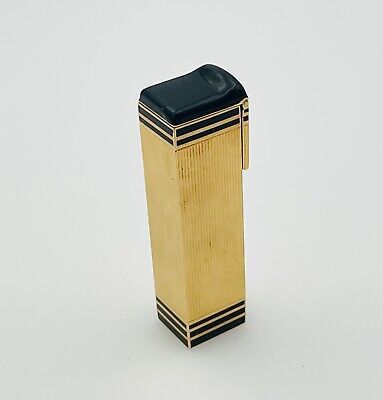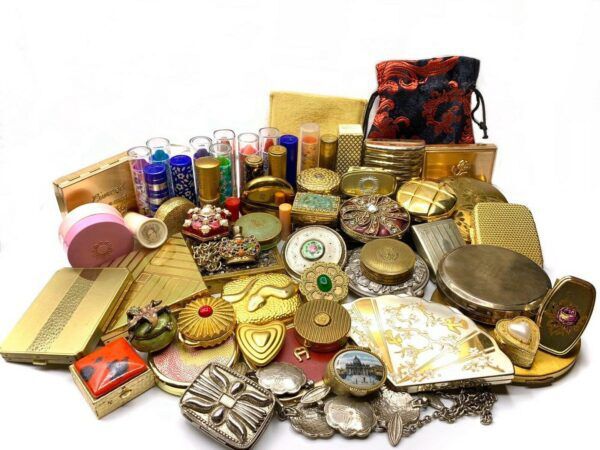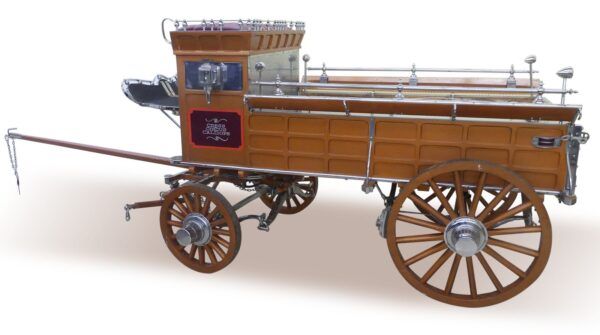#S.O.S #Surplus #Stuff #Amy #Moyer #Makeup #WorthPoint
If any S.O.S. (Surplus Old Stuff) item has an ick factor, old makeup definitely does. However, before throwing all those old lipsticks, nail polish bottles, and powder puffs in ye olde circular file, it is worth taking a closer look for surprise treasures in your vanity. Read on to learn what to do with your inevitable cache of S.O.S. (Surplus Old Stuff): Old Makeup.
Jezebel and Nefertiti
One of my secrets as a reseller is that I love estate sales that are house “clean-outs.” You can rummage through old drawers looking for treasures, which may include vintage cosmetics such as collectible compacts and mod lipstick tubes. I enjoy heading upstairs to the primary bedroom and opening the bedside table and dresser drawers, mostly looking for tucked-away jewelry but often finding other items like eyeglasses and old makeup instead. To be honest, it is there where I’ve adopted some of my aversion to old makeup; while I have found treasures for sure, I have also found my fair share of half-used lipsticks, germy powder puffs, and caked eyeshadow. Still, as a treasure hunter, it is always worth the dig since I have also found antique miniature perfumes and vintage lipsticks that were never used, all resold for hundreds of dollars.

While the old makeup clogging your bathroom cabinets is likely less than fifty years old, cosmetics have a long and storied past. Both men and women have worn makeup at various times in history, although the documentation of painted women is more robust. The Old Testament speaks of Jezebel painting her eyelids, and Egyptian Nefertiti donned African kohl eyeliner. Japanese geisha are known for their pallid, doll-like powdered white faces with bold eye and lip coloring, and by the time the 19th century rolled around, influences from worldwide cultures infiltrated the West.
However, in the late 19th century and early 20th century, women wearing makeup were generally frowned upon or hired. Yes, cosmetics in Europe and America were worn mainly by “ladies of the night” during these years. By the 1920s, face paint became more commonplace, especially during the nascent years of Hollywood. Natch film stars like Theda Bara needed a touch of rouge and lipstick to make their features pop on the big black-and-white screen.
From Department Stores to Drugstores
Today, many a drugstore is occupied in large part with shelves of cosmetics. There are natural and organic brands, TikTok-promoted brands, and, of course, the old standbys like Maybelline and Revlon. While department stores used to be “the place” to shop for the best in makeup from Chanel to Guerlain, many of these old-school stores have gone out of business, and stores like Sephora have taken their place to stock these brands. Between the drugstores, the department stores, and the specialty stores, many folks these days have boxes, bins, and drawers stuffed chockablock with cosmetics, new and old.
Pass on the Pathogens
So what to do with old makeup? As I mentioned at the start of this saga, some old makeup has an ick factor. Between the half-used lipsticks, compacts with crumbling palettes, and solidified nail polish bottles, one should certainly be wary of germs aplenty. However, not all old makeup is packed with pathogens; some may even be worth a pretty penny. This is especially true for old cosmetics from the early to mid-20th century.
5 Steps for S.O.S. (Surplus Old Stuff): Old Makeup
- Check for silver and gold. Everything from powder compacts to lipstick tubes has been made in fine metals like silver and gold. As you sift through a box of old makeup, it is easy to check for these metals by touch (coolness) and weight (heavier than plastic). Even if you find an old cosmetic made with metal that is not silver or gold, it is still likely vintage and worth checking its value.
- Vie for vintage. Some vintage makeup came in metal cases, but some came in plastic. Thanks to the advent of early plastics like Bakelite, cosmetic manufacturers had a new option for mass-producing wares. The easiest way to see if you have vintage makeup in plastic packaging is to eyeball it and pick out obvious art deco, art nouveau, or MCM designs. Original packaging is a bonus.
- Perfume is a plus. Unlike some cosmetic categories, perfume is almost always a winner in the resale market. Yes, folks even buy half-empty or completely empty bottles of perfume. Some are nostalgic for retired fragrances, and some are perfume bottle collectors. Perfume bottles have eternally been a place for cosmetic houses to showcase fine designs and eye-catching labels, so they quickly became a hot collectible in the 20th century.
- Avon and Mary Kay, not so much. Since Avon and Mary Kay are more budget-friendly brands, their resale value remains low. However, watch for the scarce outliers like Avon’s Little Blossom blush or vintage Mary Kay giveaways like their 1980s Polaroid camera.
- Toss the tainted. Now for the germs! Once you’ve weeded out the good stuff worth selling on the resale market, toss all the stuff with a visible ick factor. Smashed lipsticks, lung-clogging powder packages, and especially those petri dish plastic-cased mascaras are all best tossed in the trash.
Now that you have successfully culled your old makeup stash, find your favorite resale website or local vintage shop to sell your goodies. You may just end up with a few dollars in your pocket and fewer germs in your vanity drawers!
Amy Moyer is the proprietor of Antmuffin: Art, Antiques & Collectibles. She holds a B.A. in Visual Art from Brown University and lives in Boston.
WorthPoint—Discover. Value. Preserve.




